Comprehensive Analysis of Companies and Partnership Law Assignment
VerifiedAdded on 2020/03/04
|10
|1955
|50
Homework Assignment
AI Summary
This assignment analyzes key aspects of Companies and Partnership Law, beginning with the definition of partnerships under the Partnership Act 1958 and exploring the legal principles governing partnerships. It examines the requirements for business names and the role of the Australian Securities and Investments Commission (ASIC) in business registration. The assignment delves into the misuse of confidential information by former employees and the legal recourse available to employers, citing relevant cases like Gilford Motor Company Ltd v Horne. Furthermore, it explains the concept of the corporate veil, its implications, and circumstances under which it can be pierced, referencing cases such as Salomon v Salomon and Co. Ltd. The assignment concludes by highlighting the ASIC's role in regulating markets and addressing misconduct, particularly in the context of corporate law violations. The assignment provides a comprehensive overview of legal principles, relevant cases, and research evidence related to Companies and Partnership Law.
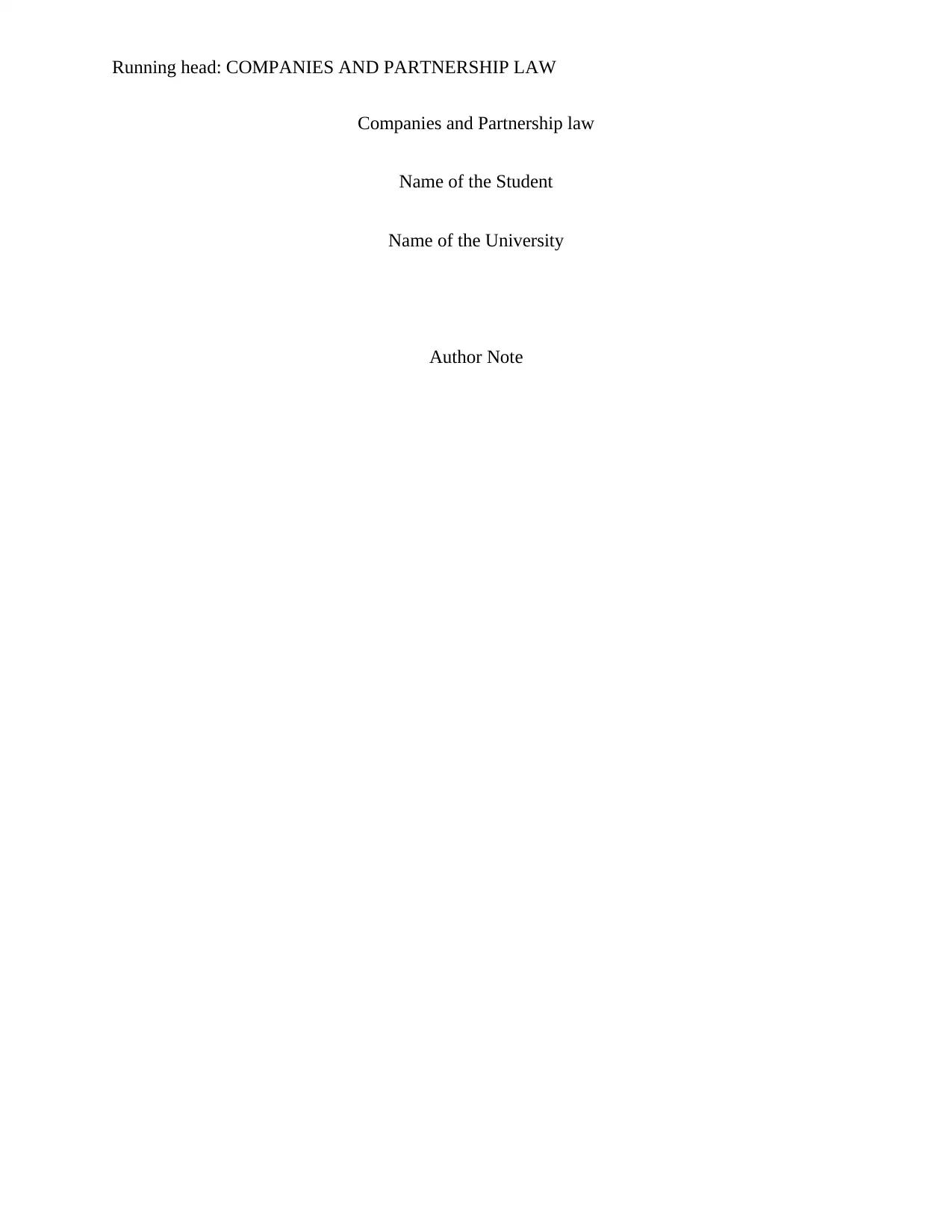
Running head: COMPANIES AND PARTNERSHIP LAW
Companies and Partnership law
Name of the Student
Name of the University
Author Note
Companies and Partnership law
Name of the Student
Name of the University
Author Note
Paraphrase This Document
Need a fresh take? Get an instant paraphrase of this document with our AI Paraphraser
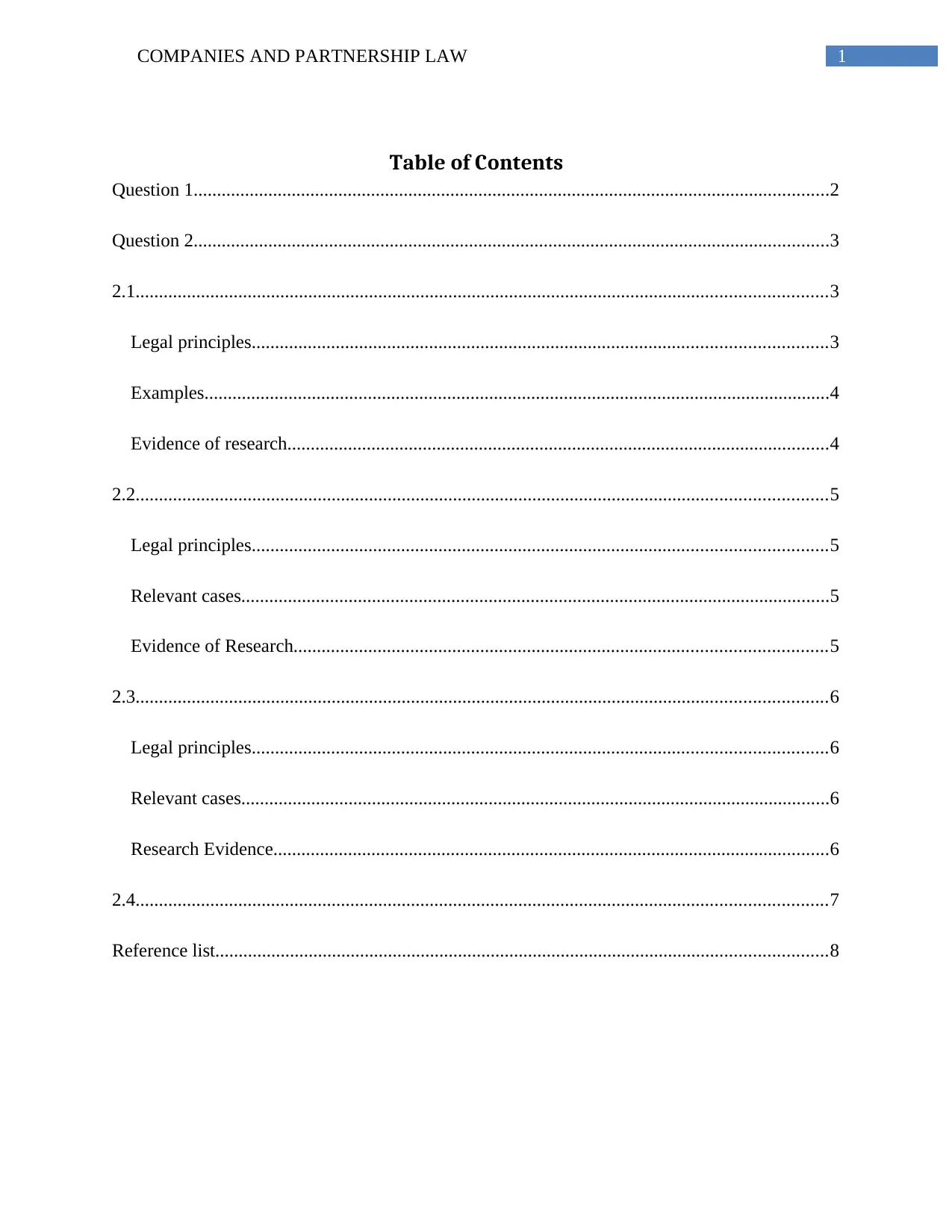
1COMPANIES AND PARTNERSHIP LAW
Table of Contents
Question 1........................................................................................................................................2
Question 2........................................................................................................................................3
2.1....................................................................................................................................................3
Legal principles...........................................................................................................................3
Examples......................................................................................................................................4
Evidence of research....................................................................................................................4
2.2....................................................................................................................................................5
Legal principles...........................................................................................................................5
Relevant cases..............................................................................................................................5
Evidence of Research..................................................................................................................5
2.3....................................................................................................................................................6
Legal principles...........................................................................................................................6
Relevant cases..............................................................................................................................6
Research Evidence.......................................................................................................................6
2.4....................................................................................................................................................7
Reference list...................................................................................................................................8
Table of Contents
Question 1........................................................................................................................................2
Question 2........................................................................................................................................3
2.1....................................................................................................................................................3
Legal principles...........................................................................................................................3
Examples......................................................................................................................................4
Evidence of research....................................................................................................................4
2.2....................................................................................................................................................5
Legal principles...........................................................................................................................5
Relevant cases..............................................................................................................................5
Evidence of Research..................................................................................................................5
2.3....................................................................................................................................................6
Legal principles...........................................................................................................................6
Relevant cases..............................................................................................................................6
Research Evidence.......................................................................................................................6
2.4....................................................................................................................................................7
Reference list...................................................................................................................................8
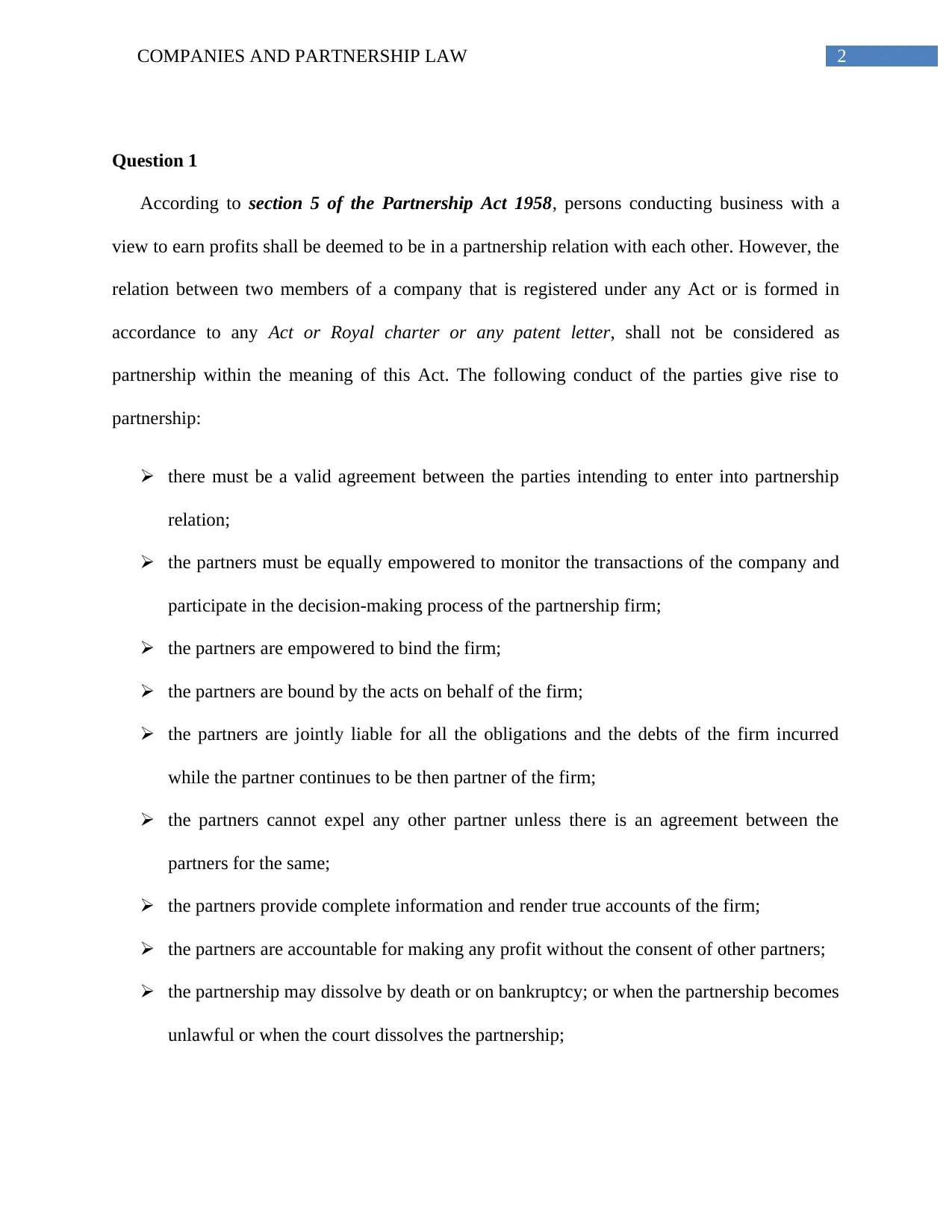
2COMPANIES AND PARTNERSHIP LAW
Question 1
According to section 5 of the Partnership Act 1958, persons conducting business with a
view to earn profits shall be deemed to be in a partnership relation with each other. However, the
relation between two members of a company that is registered under any Act or is formed in
accordance to any Act or Royal charter or any patent letter, shall not be considered as
partnership within the meaning of this Act. The following conduct of the parties give rise to
partnership:
there must be a valid agreement between the parties intending to enter into partnership
relation;
the partners must be equally empowered to monitor the transactions of the company and
participate in the decision-making process of the partnership firm;
the partners are empowered to bind the firm;
the partners are bound by the acts on behalf of the firm;
the partners are jointly liable for all the obligations and the debts of the firm incurred
while the partner continues to be then partner of the firm;
the partners cannot expel any other partner unless there is an agreement between the
partners for the same;
the partners provide complete information and render true accounts of the firm;
the partners are accountable for making any profit without the consent of other partners;
the partnership may dissolve by death or on bankruptcy; or when the partnership becomes
unlawful or when the court dissolves the partnership;
Question 1
According to section 5 of the Partnership Act 1958, persons conducting business with a
view to earn profits shall be deemed to be in a partnership relation with each other. However, the
relation between two members of a company that is registered under any Act or is formed in
accordance to any Act or Royal charter or any patent letter, shall not be considered as
partnership within the meaning of this Act. The following conduct of the parties give rise to
partnership:
there must be a valid agreement between the parties intending to enter into partnership
relation;
the partners must be equally empowered to monitor the transactions of the company and
participate in the decision-making process of the partnership firm;
the partners are empowered to bind the firm;
the partners are bound by the acts on behalf of the firm;
the partners are jointly liable for all the obligations and the debts of the firm incurred
while the partner continues to be then partner of the firm;
the partners cannot expel any other partner unless there is an agreement between the
partners for the same;
the partners provide complete information and render true accounts of the firm;
the partners are accountable for making any profit without the consent of other partners;
the partnership may dissolve by death or on bankruptcy; or when the partnership becomes
unlawful or when the court dissolves the partnership;
⊘ This is a preview!⊘
Do you want full access?
Subscribe today to unlock all pages.

Trusted by 1+ million students worldwide
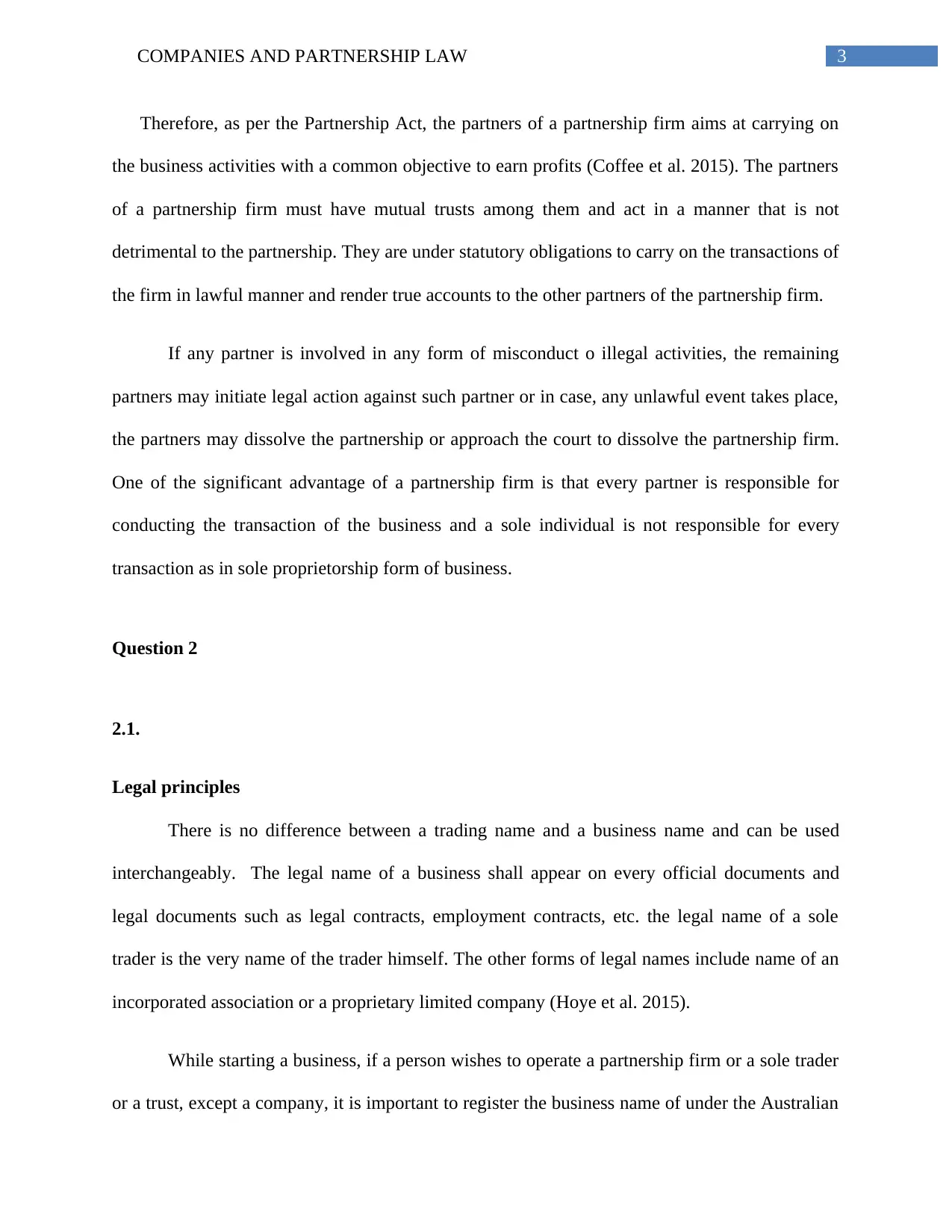
3COMPANIES AND PARTNERSHIP LAW
Therefore, as per the Partnership Act, the partners of a partnership firm aims at carrying on
the business activities with a common objective to earn profits (Coffee et al. 2015). The partners
of a partnership firm must have mutual trusts among them and act in a manner that is not
detrimental to the partnership. They are under statutory obligations to carry on the transactions of
the firm in lawful manner and render true accounts to the other partners of the partnership firm.
If any partner is involved in any form of misconduct o illegal activities, the remaining
partners may initiate legal action against such partner or in case, any unlawful event takes place,
the partners may dissolve the partnership or approach the court to dissolve the partnership firm.
One of the significant advantage of a partnership firm is that every partner is responsible for
conducting the transaction of the business and a sole individual is not responsible for every
transaction as in sole proprietorship form of business.
Question 2
2.1.
Legal principles
There is no difference between a trading name and a business name and can be used
interchangeably. The legal name of a business shall appear on every official documents and
legal documents such as legal contracts, employment contracts, etc. the legal name of a sole
trader is the very name of the trader himself. The other forms of legal names include name of an
incorporated association or a proprietary limited company (Hoye et al. 2015).
While starting a business, if a person wishes to operate a partnership firm or a sole trader
or a trust, except a company, it is important to register the business name of under the Australian
Therefore, as per the Partnership Act, the partners of a partnership firm aims at carrying on
the business activities with a common objective to earn profits (Coffee et al. 2015). The partners
of a partnership firm must have mutual trusts among them and act in a manner that is not
detrimental to the partnership. They are under statutory obligations to carry on the transactions of
the firm in lawful manner and render true accounts to the other partners of the partnership firm.
If any partner is involved in any form of misconduct o illegal activities, the remaining
partners may initiate legal action against such partner or in case, any unlawful event takes place,
the partners may dissolve the partnership or approach the court to dissolve the partnership firm.
One of the significant advantage of a partnership firm is that every partner is responsible for
conducting the transaction of the business and a sole individual is not responsible for every
transaction as in sole proprietorship form of business.
Question 2
2.1.
Legal principles
There is no difference between a trading name and a business name and can be used
interchangeably. The legal name of a business shall appear on every official documents and
legal documents such as legal contracts, employment contracts, etc. the legal name of a sole
trader is the very name of the trader himself. The other forms of legal names include name of an
incorporated association or a proprietary limited company (Hoye et al. 2015).
While starting a business, if a person wishes to operate a partnership firm or a sole trader
or a trust, except a company, it is important to register the business name of under the Australian
Paraphrase This Document
Need a fresh take? Get an instant paraphrase of this document with our AI Paraphraser
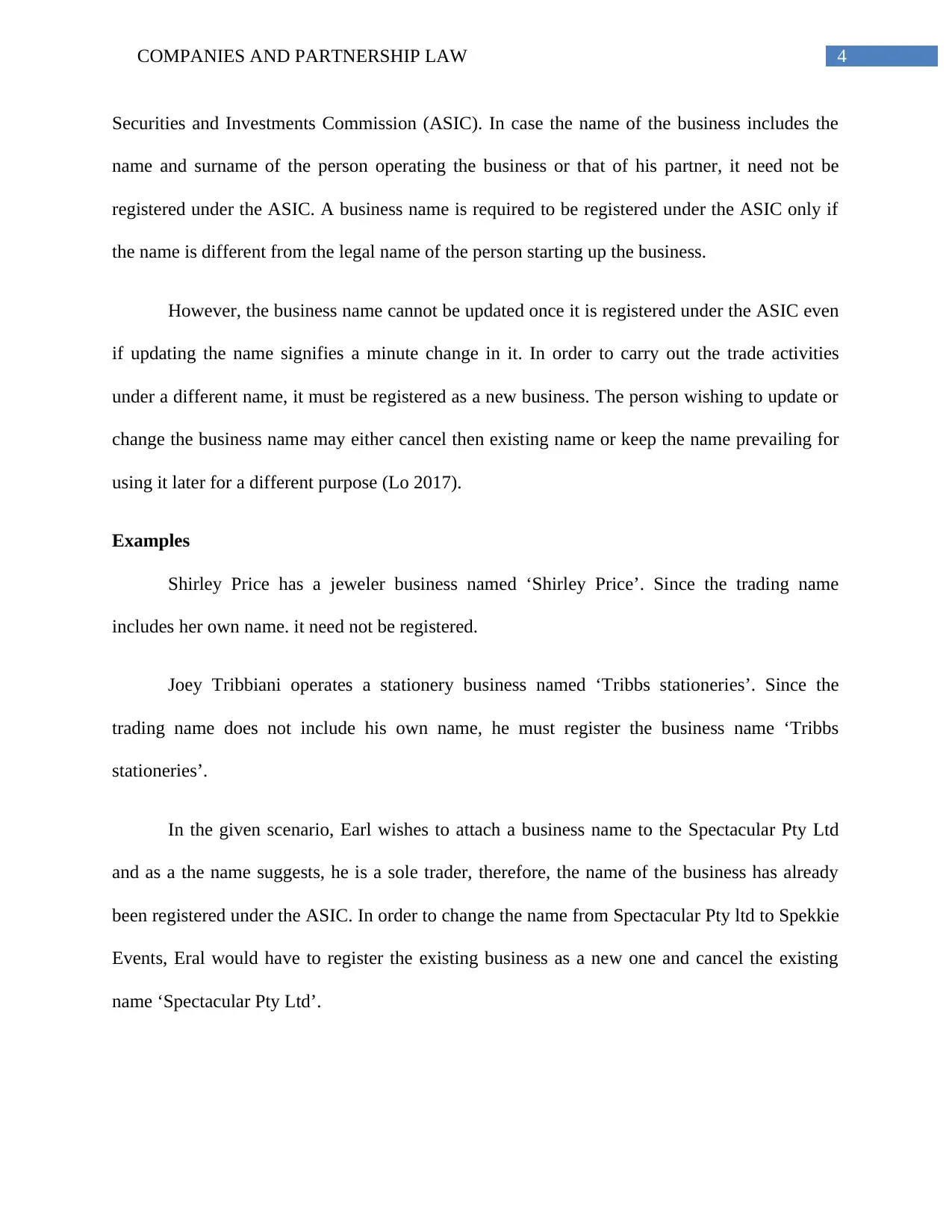
4COMPANIES AND PARTNERSHIP LAW
Securities and Investments Commission (ASIC). In case the name of the business includes the
name and surname of the person operating the business or that of his partner, it need not be
registered under the ASIC. A business name is required to be registered under the ASIC only if
the name is different from the legal name of the person starting up the business.
However, the business name cannot be updated once it is registered under the ASIC even
if updating the name signifies a minute change in it. In order to carry out the trade activities
under a different name, it must be registered as a new business. The person wishing to update or
change the business name may either cancel then existing name or keep the name prevailing for
using it later for a different purpose (Lo 2017).
Examples
Shirley Price has a jeweler business named ‘Shirley Price’. Since the trading name
includes her own name. it need not be registered.
Joey Tribbiani operates a stationery business named ‘Tribbs stationeries’. Since the
trading name does not include his own name, he must register the business name ‘Tribbs
stationeries’.
In the given scenario, Earl wishes to attach a business name to the Spectacular Pty Ltd
and as a the name suggests, he is a sole trader, therefore, the name of the business has already
been registered under the ASIC. In order to change the name from Spectacular Pty ltd to Spekkie
Events, Eral would have to register the existing business as a new one and cancel the existing
name ‘Spectacular Pty Ltd’.
Securities and Investments Commission (ASIC). In case the name of the business includes the
name and surname of the person operating the business or that of his partner, it need not be
registered under the ASIC. A business name is required to be registered under the ASIC only if
the name is different from the legal name of the person starting up the business.
However, the business name cannot be updated once it is registered under the ASIC even
if updating the name signifies a minute change in it. In order to carry out the trade activities
under a different name, it must be registered as a new business. The person wishing to update or
change the business name may either cancel then existing name or keep the name prevailing for
using it later for a different purpose (Lo 2017).
Examples
Shirley Price has a jeweler business named ‘Shirley Price’. Since the trading name
includes her own name. it need not be registered.
Joey Tribbiani operates a stationery business named ‘Tribbs stationeries’. Since the
trading name does not include his own name, he must register the business name ‘Tribbs
stationeries’.
In the given scenario, Earl wishes to attach a business name to the Spectacular Pty Ltd
and as a the name suggests, he is a sole trader, therefore, the name of the business has already
been registered under the ASIC. In order to change the name from Spectacular Pty ltd to Spekkie
Events, Eral would have to register the existing business as a new one and cancel the existing
name ‘Spectacular Pty Ltd’.
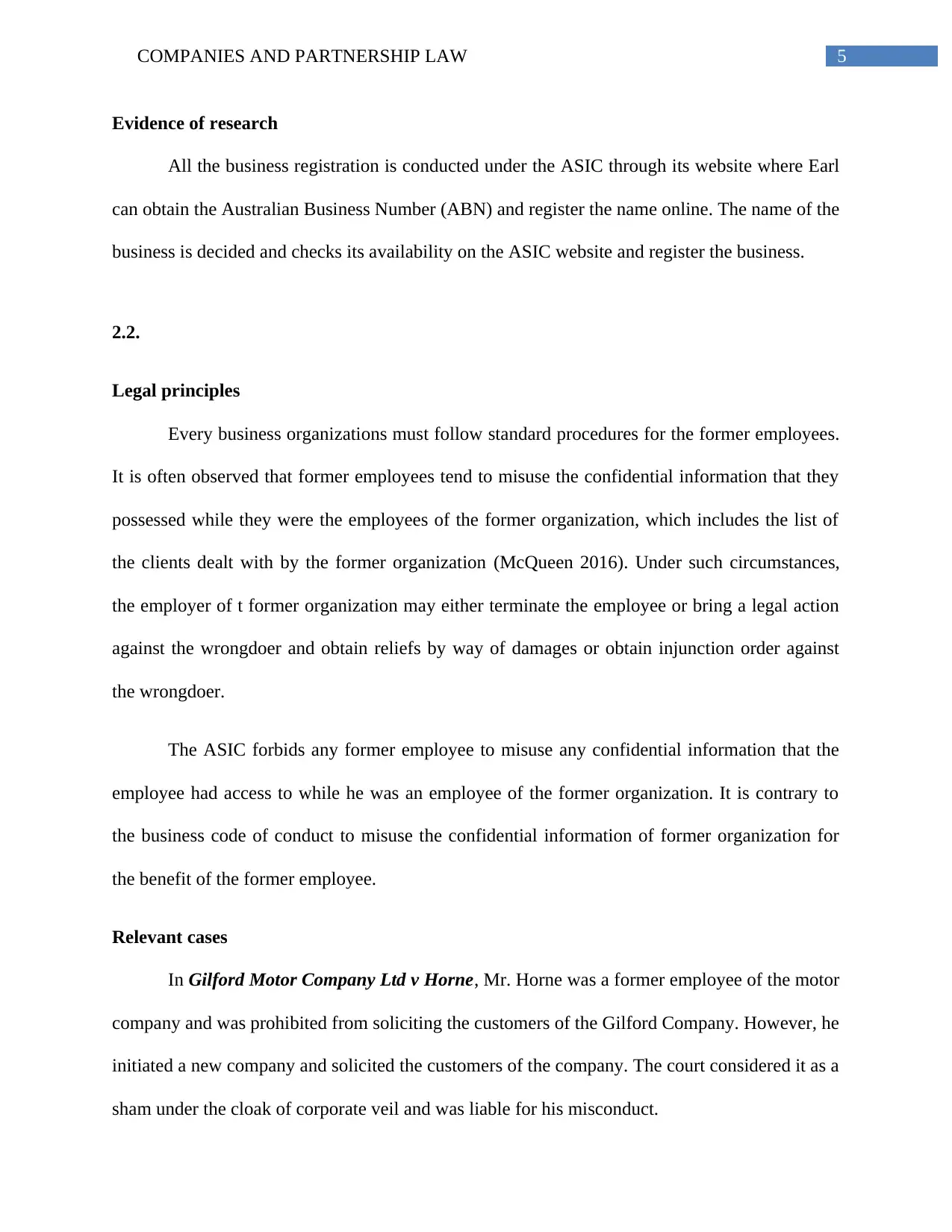
5COMPANIES AND PARTNERSHIP LAW
Evidence of research
All the business registration is conducted under the ASIC through its website where Earl
can obtain the Australian Business Number (ABN) and register the name online. The name of the
business is decided and checks its availability on the ASIC website and register the business.
2.2.
Legal principles
Every business organizations must follow standard procedures for the former employees.
It is often observed that former employees tend to misuse the confidential information that they
possessed while they were the employees of the former organization, which includes the list of
the clients dealt with by the former organization (McQueen 2016). Under such circumstances,
the employer of t former organization may either terminate the employee or bring a legal action
against the wrongdoer and obtain reliefs by way of damages or obtain injunction order against
the wrongdoer.
The ASIC forbids any former employee to misuse any confidential information that the
employee had access to while he was an employee of the former organization. It is contrary to
the business code of conduct to misuse the confidential information of former organization for
the benefit of the former employee.
Relevant cases
In Gilford Motor Company Ltd v Horne, Mr. Horne was a former employee of the motor
company and was prohibited from soliciting the customers of the Gilford Company. However, he
initiated a new company and solicited the customers of the company. The court considered it as a
sham under the cloak of corporate veil and was liable for his misconduct.
Evidence of research
All the business registration is conducted under the ASIC through its website where Earl
can obtain the Australian Business Number (ABN) and register the name online. The name of the
business is decided and checks its availability on the ASIC website and register the business.
2.2.
Legal principles
Every business organizations must follow standard procedures for the former employees.
It is often observed that former employees tend to misuse the confidential information that they
possessed while they were the employees of the former organization, which includes the list of
the clients dealt with by the former organization (McQueen 2016). Under such circumstances,
the employer of t former organization may either terminate the employee or bring a legal action
against the wrongdoer and obtain reliefs by way of damages or obtain injunction order against
the wrongdoer.
The ASIC forbids any former employee to misuse any confidential information that the
employee had access to while he was an employee of the former organization. It is contrary to
the business code of conduct to misuse the confidential information of former organization for
the benefit of the former employee.
Relevant cases
In Gilford Motor Company Ltd v Horne, Mr. Horne was a former employee of the motor
company and was prohibited from soliciting the customers of the Gilford Company. However, he
initiated a new company and solicited the customers of the company. The court considered it as a
sham under the cloak of corporate veil and was liable for his misconduct.
⊘ This is a preview!⊘
Do you want full access?
Subscribe today to unlock all pages.

Trusted by 1+ million students worldwide
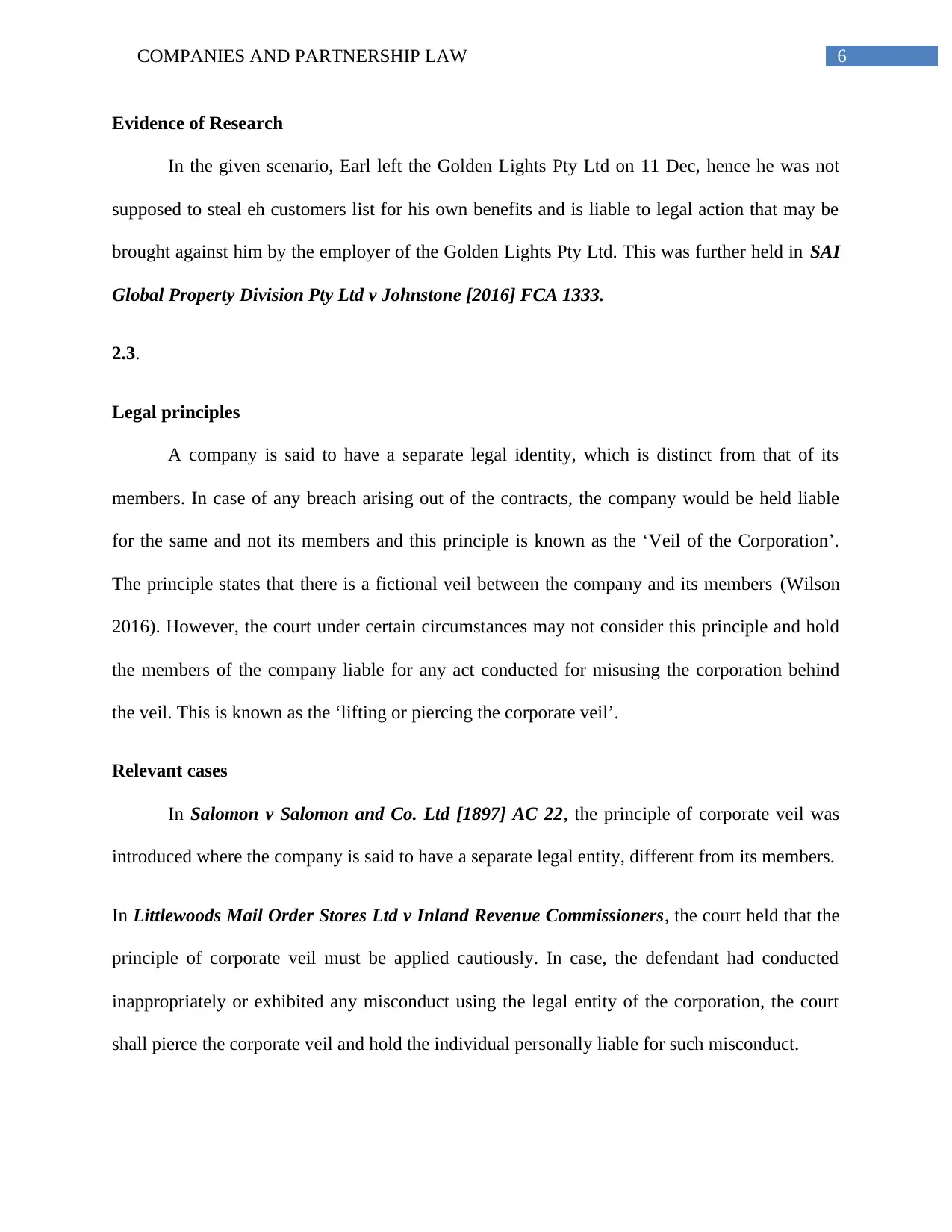
6COMPANIES AND PARTNERSHIP LAW
Evidence of Research
In the given scenario, Earl left the Golden Lights Pty Ltd on 11 Dec, hence he was not
supposed to steal eh customers list for his own benefits and is liable to legal action that may be
brought against him by the employer of the Golden Lights Pty Ltd. This was further held in SAI
Global Property Division Pty Ltd v Johnstone [2016] FCA 1333.
2.3.
Legal principles
A company is said to have a separate legal identity, which is distinct from that of its
members. In case of any breach arising out of the contracts, the company would be held liable
for the same and not its members and this principle is known as the ‘Veil of the Corporation’.
The principle states that there is a fictional veil between the company and its members (Wilson
2016). However, the court under certain circumstances may not consider this principle and hold
the members of the company liable for any act conducted for misusing the corporation behind
the veil. This is known as the ‘lifting or piercing the corporate veil’.
Relevant cases
In Salomon v Salomon and Co. Ltd [1897] AC 22, the principle of corporate veil was
introduced where the company is said to have a separate legal entity, different from its members.
In Littlewoods Mail Order Stores Ltd v Inland Revenue Commissioners, the court held that the
principle of corporate veil must be applied cautiously. In case, the defendant had conducted
inappropriately or exhibited any misconduct using the legal entity of the corporation, the court
shall pierce the corporate veil and hold the individual personally liable for such misconduct.
Evidence of Research
In the given scenario, Earl left the Golden Lights Pty Ltd on 11 Dec, hence he was not
supposed to steal eh customers list for his own benefits and is liable to legal action that may be
brought against him by the employer of the Golden Lights Pty Ltd. This was further held in SAI
Global Property Division Pty Ltd v Johnstone [2016] FCA 1333.
2.3.
Legal principles
A company is said to have a separate legal identity, which is distinct from that of its
members. In case of any breach arising out of the contracts, the company would be held liable
for the same and not its members and this principle is known as the ‘Veil of the Corporation’.
The principle states that there is a fictional veil between the company and its members (Wilson
2016). However, the court under certain circumstances may not consider this principle and hold
the members of the company liable for any act conducted for misusing the corporation behind
the veil. This is known as the ‘lifting or piercing the corporate veil’.
Relevant cases
In Salomon v Salomon and Co. Ltd [1897] AC 22, the principle of corporate veil was
introduced where the company is said to have a separate legal entity, different from its members.
In Littlewoods Mail Order Stores Ltd v Inland Revenue Commissioners, the court held that the
principle of corporate veil must be applied cautiously. In case, the defendant had conducted
inappropriately or exhibited any misconduct using the legal entity of the corporation, the court
shall pierce the corporate veil and hold the individual personally liable for such misconduct.
Paraphrase This Document
Need a fresh take? Get an instant paraphrase of this document with our AI Paraphraser
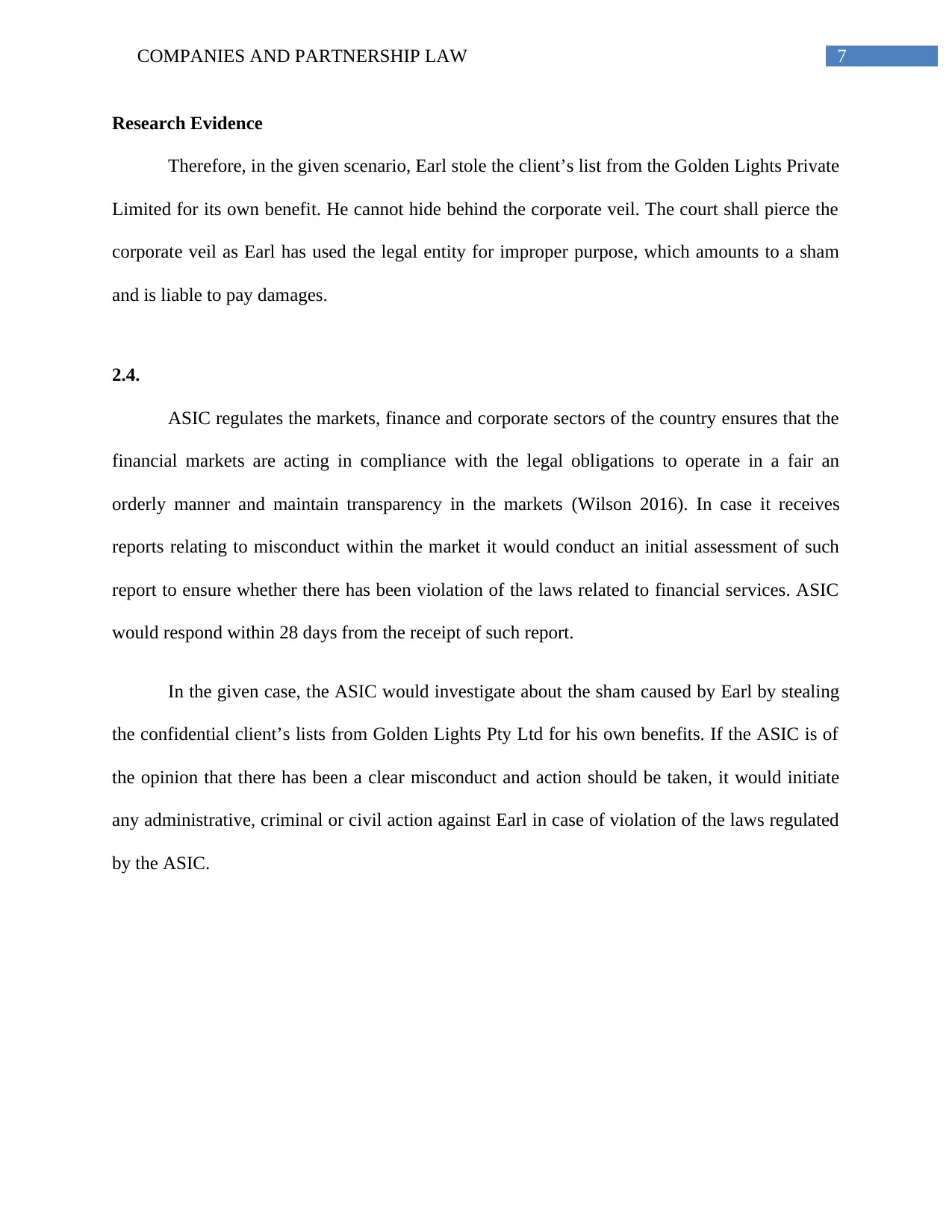
7COMPANIES AND PARTNERSHIP LAW
Research Evidence
Therefore, in the given scenario, Earl stole the client’s list from the Golden Lights Private
Limited for its own benefit. He cannot hide behind the corporate veil. The court shall pierce the
corporate veil as Earl has used the legal entity for improper purpose, which amounts to a sham
and is liable to pay damages.
2.4.
ASIC regulates the markets, finance and corporate sectors of the country ensures that the
financial markets are acting in compliance with the legal obligations to operate in a fair an
orderly manner and maintain transparency in the markets (Wilson 2016). In case it receives
reports relating to misconduct within the market it would conduct an initial assessment of such
report to ensure whether there has been violation of the laws related to financial services. ASIC
would respond within 28 days from the receipt of such report.
In the given case, the ASIC would investigate about the sham caused by Earl by stealing
the confidential client’s lists from Golden Lights Pty Ltd for his own benefits. If the ASIC is of
the opinion that there has been a clear misconduct and action should be taken, it would initiate
any administrative, criminal or civil action against Earl in case of violation of the laws regulated
by the ASIC.
Research Evidence
Therefore, in the given scenario, Earl stole the client’s list from the Golden Lights Private
Limited for its own benefit. He cannot hide behind the corporate veil. The court shall pierce the
corporate veil as Earl has used the legal entity for improper purpose, which amounts to a sham
and is liable to pay damages.
2.4.
ASIC regulates the markets, finance and corporate sectors of the country ensures that the
financial markets are acting in compliance with the legal obligations to operate in a fair an
orderly manner and maintain transparency in the markets (Wilson 2016). In case it receives
reports relating to misconduct within the market it would conduct an initial assessment of such
report to ensure whether there has been violation of the laws related to financial services. ASIC
would respond within 28 days from the receipt of such report.
In the given case, the ASIC would investigate about the sham caused by Earl by stealing
the confidential client’s lists from Golden Lights Pty Ltd for his own benefits. If the ASIC is of
the opinion that there has been a clear misconduct and action should be taken, it would initiate
any administrative, criminal or civil action against Earl in case of violation of the laws regulated
by the ASIC.
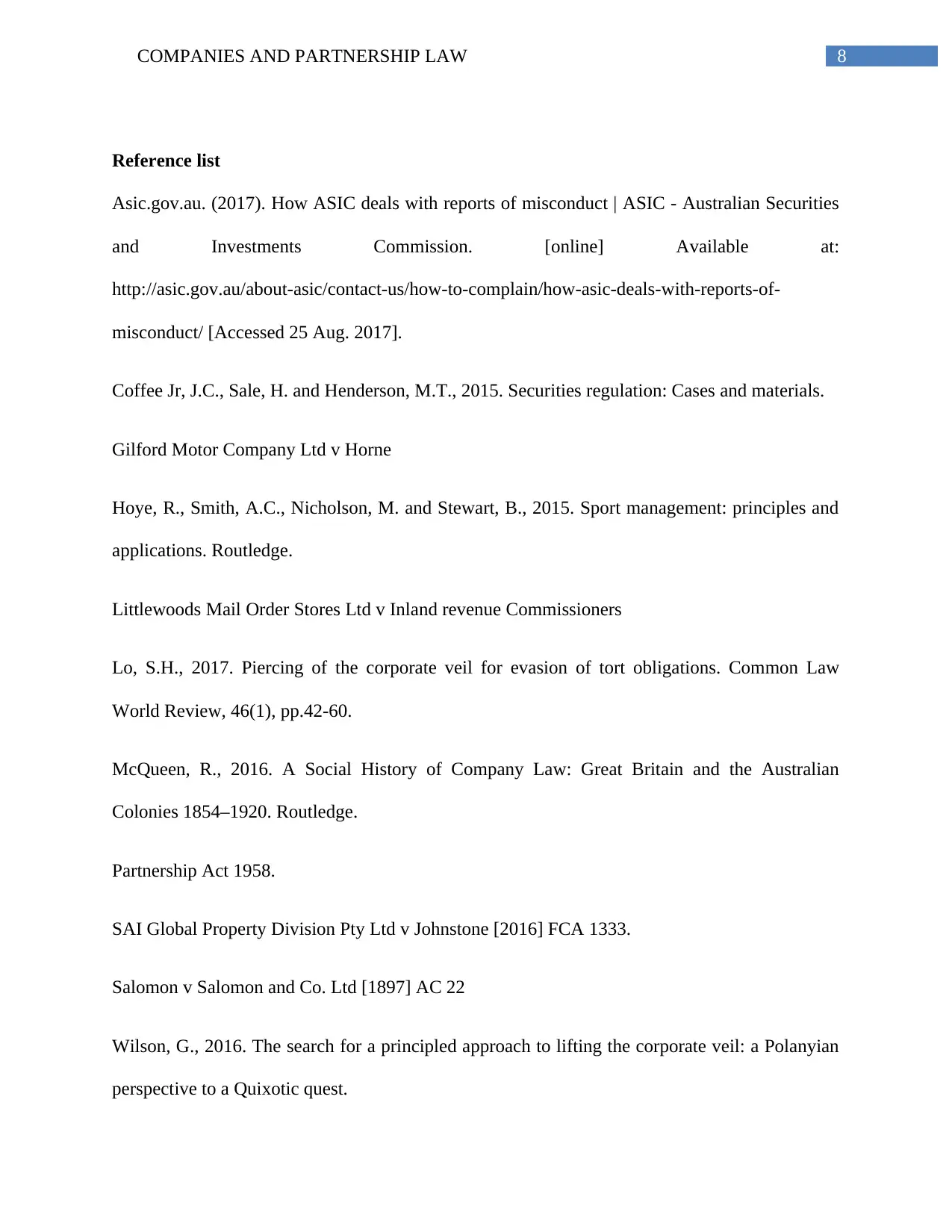
8COMPANIES AND PARTNERSHIP LAW
Reference list
Asic.gov.au. (2017). How ASIC deals with reports of misconduct | ASIC - Australian Securities
and Investments Commission. [online] Available at:
http://asic.gov.au/about-asic/contact-us/how-to-complain/how-asic-deals-with-reports-of-
misconduct/ [Accessed 25 Aug. 2017].
Coffee Jr, J.C., Sale, H. and Henderson, M.T., 2015. Securities regulation: Cases and materials.
Gilford Motor Company Ltd v Horne
Hoye, R., Smith, A.C., Nicholson, M. and Stewart, B., 2015. Sport management: principles and
applications. Routledge.
Littlewoods Mail Order Stores Ltd v Inland revenue Commissioners
Lo, S.H., 2017. Piercing of the corporate veil for evasion of tort obligations. Common Law
World Review, 46(1), pp.42-60.
McQueen, R., 2016. A Social History of Company Law: Great Britain and the Australian
Colonies 1854–1920. Routledge.
Partnership Act 1958.
SAI Global Property Division Pty Ltd v Johnstone [2016] FCA 1333.
Salomon v Salomon and Co. Ltd [1897] AC 22
Wilson, G., 2016. The search for a principled approach to lifting the corporate veil: a Polanyian
perspective to a Quixotic quest.
Reference list
Asic.gov.au. (2017). How ASIC deals with reports of misconduct | ASIC - Australian Securities
and Investments Commission. [online] Available at:
http://asic.gov.au/about-asic/contact-us/how-to-complain/how-asic-deals-with-reports-of-
misconduct/ [Accessed 25 Aug. 2017].
Coffee Jr, J.C., Sale, H. and Henderson, M.T., 2015. Securities regulation: Cases and materials.
Gilford Motor Company Ltd v Horne
Hoye, R., Smith, A.C., Nicholson, M. and Stewart, B., 2015. Sport management: principles and
applications. Routledge.
Littlewoods Mail Order Stores Ltd v Inland revenue Commissioners
Lo, S.H., 2017. Piercing of the corporate veil for evasion of tort obligations. Common Law
World Review, 46(1), pp.42-60.
McQueen, R., 2016. A Social History of Company Law: Great Britain and the Australian
Colonies 1854–1920. Routledge.
Partnership Act 1958.
SAI Global Property Division Pty Ltd v Johnstone [2016] FCA 1333.
Salomon v Salomon and Co. Ltd [1897] AC 22
Wilson, G., 2016. The search for a principled approach to lifting the corporate veil: a Polanyian
perspective to a Quixotic quest.
⊘ This is a preview!⊘
Do you want full access?
Subscribe today to unlock all pages.

Trusted by 1+ million students worldwide

9COMPANIES AND PARTNERSHIP LAW
1 out of 10
Related Documents
Your All-in-One AI-Powered Toolkit for Academic Success.
+13062052269
info@desklib.com
Available 24*7 on WhatsApp / Email
![[object Object]](/_next/static/media/star-bottom.7253800d.svg)
Unlock your academic potential
Copyright © 2020–2025 A2Z Services. All Rights Reserved. Developed and managed by ZUCOL.





